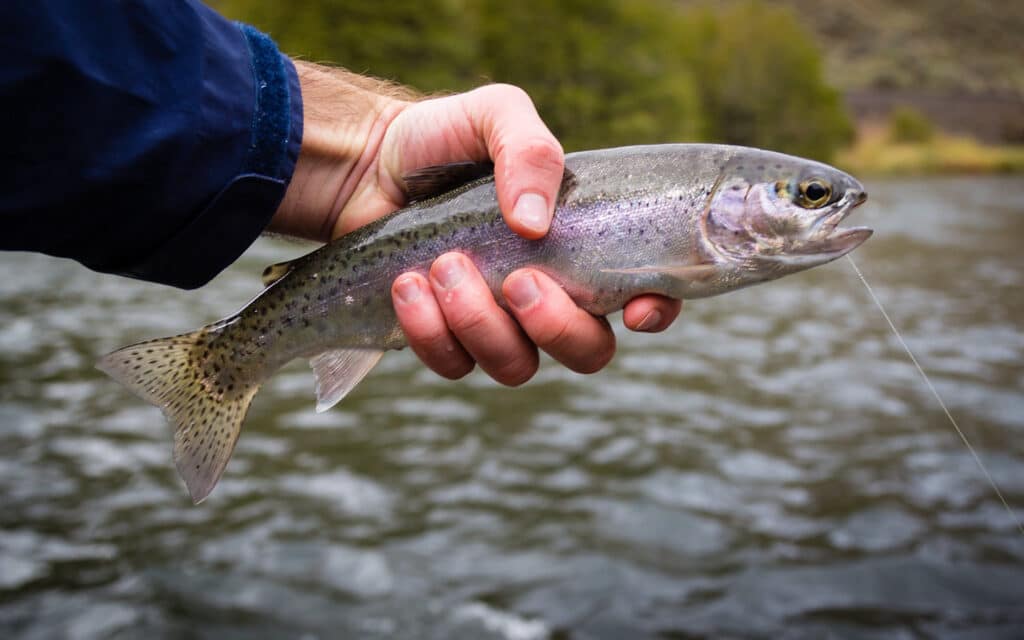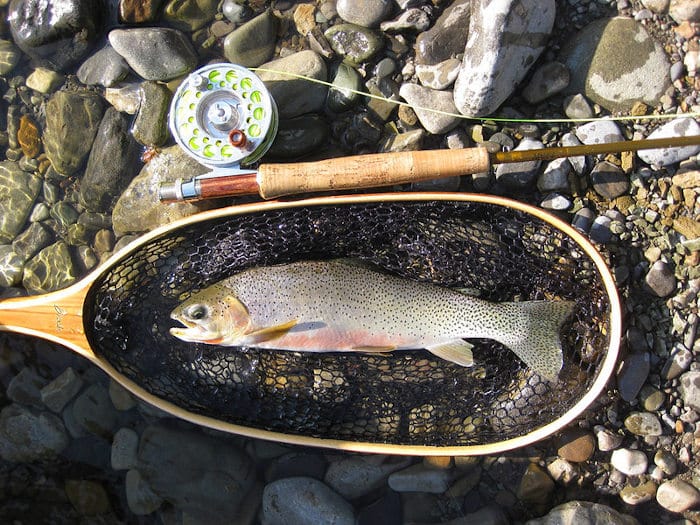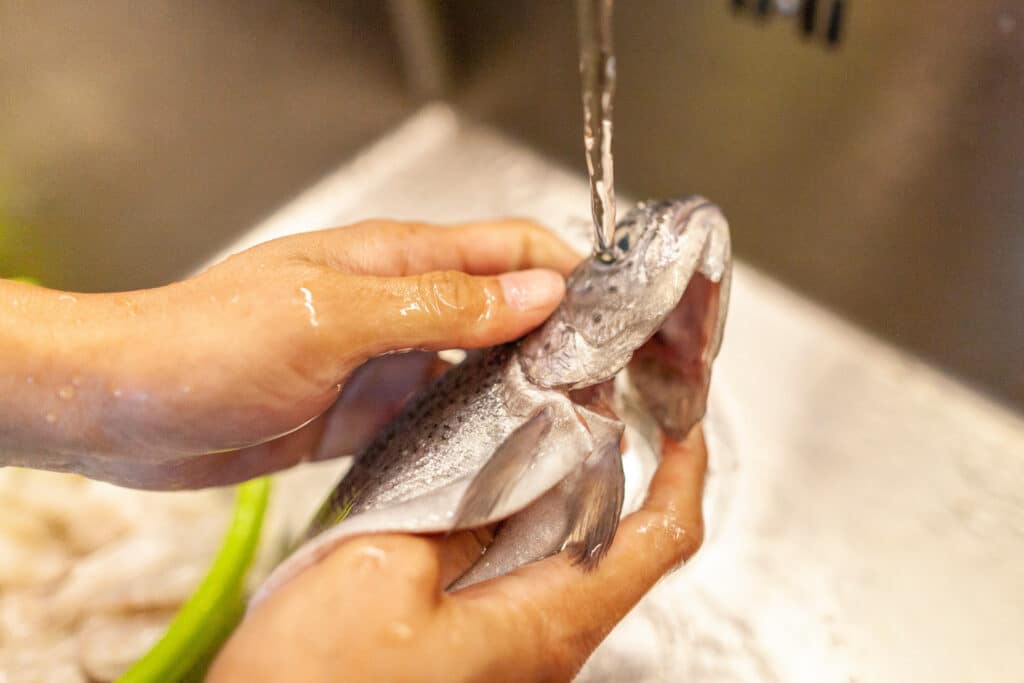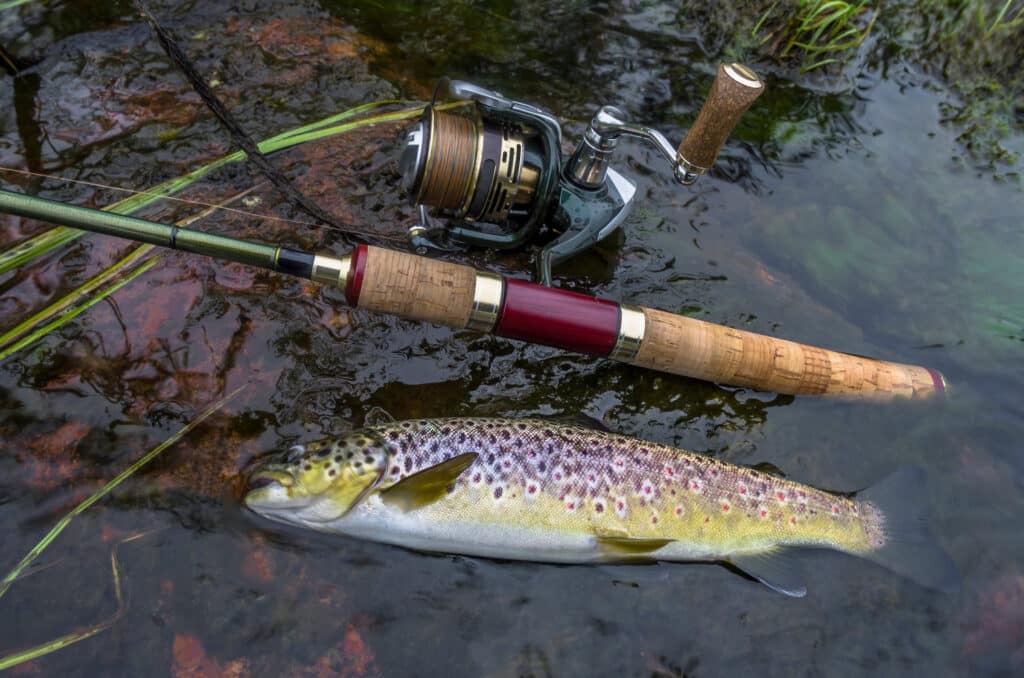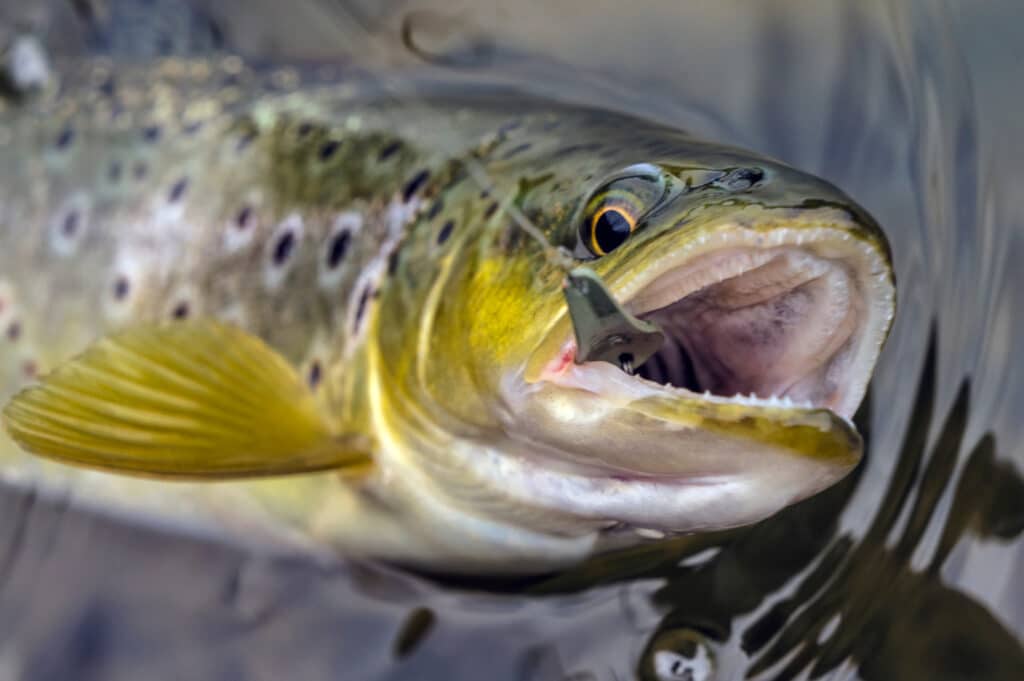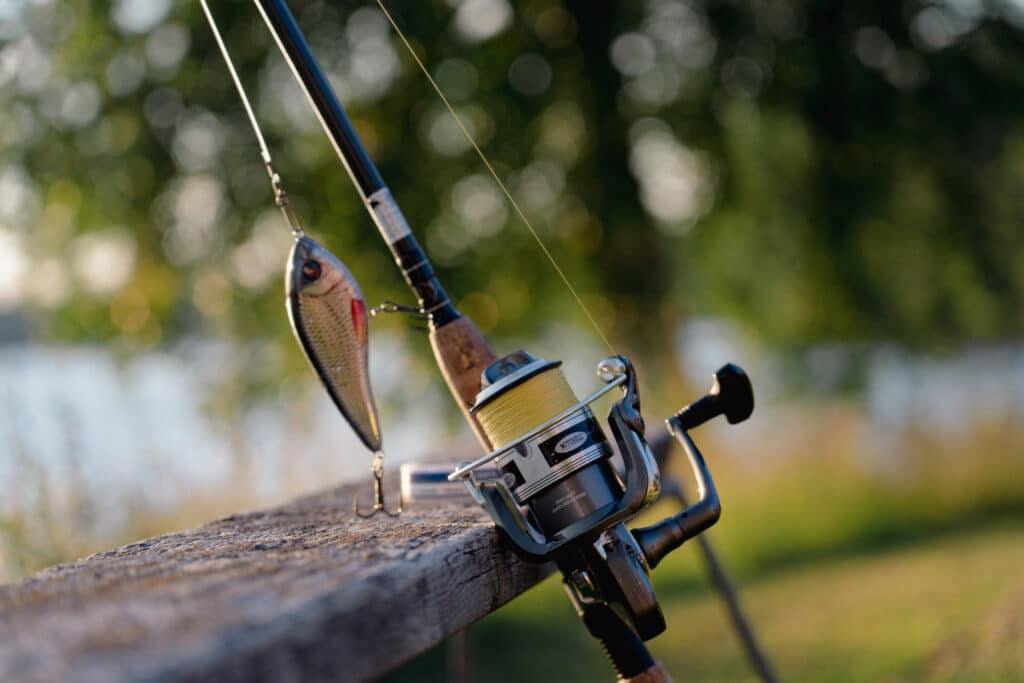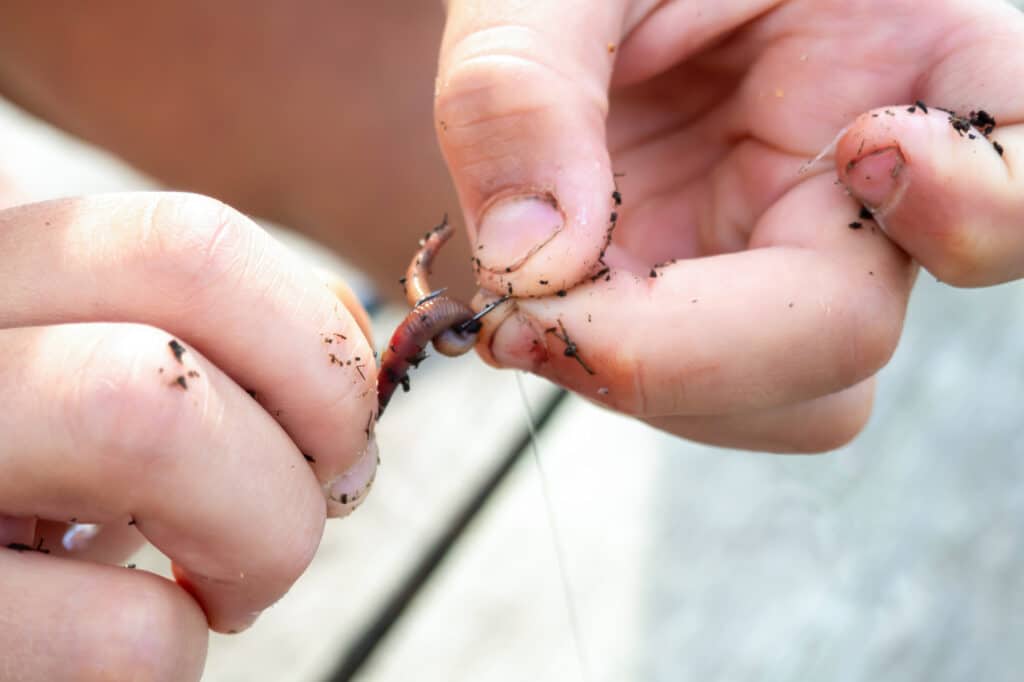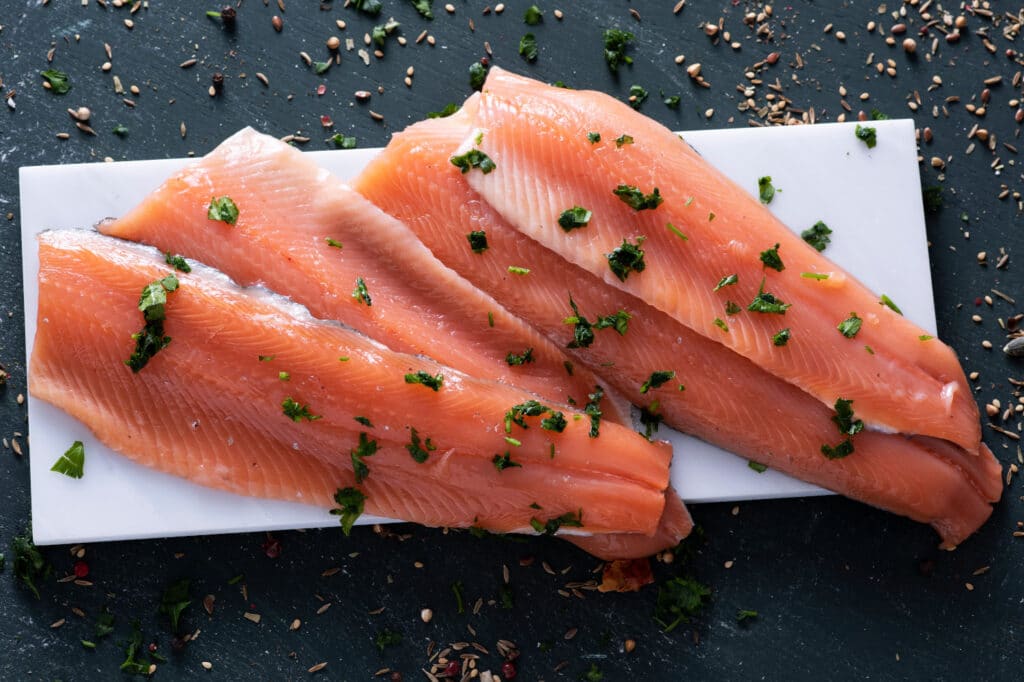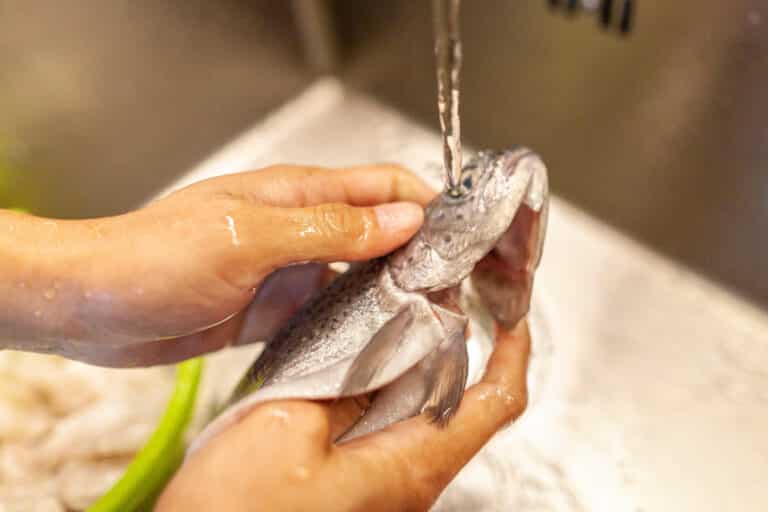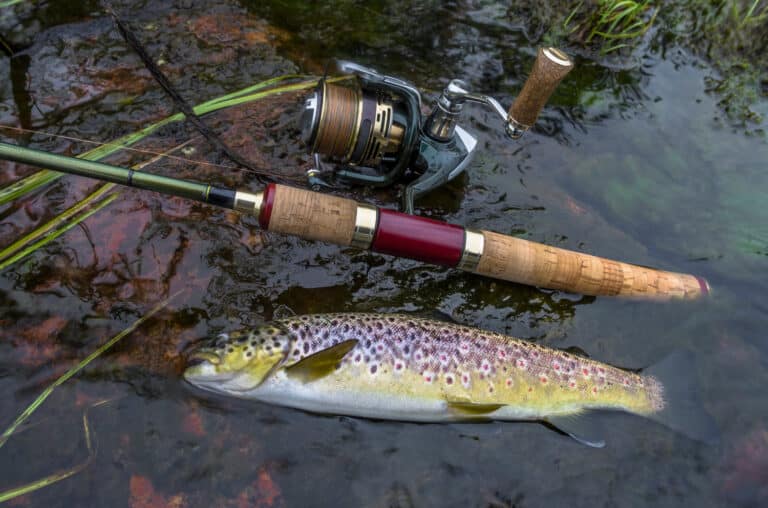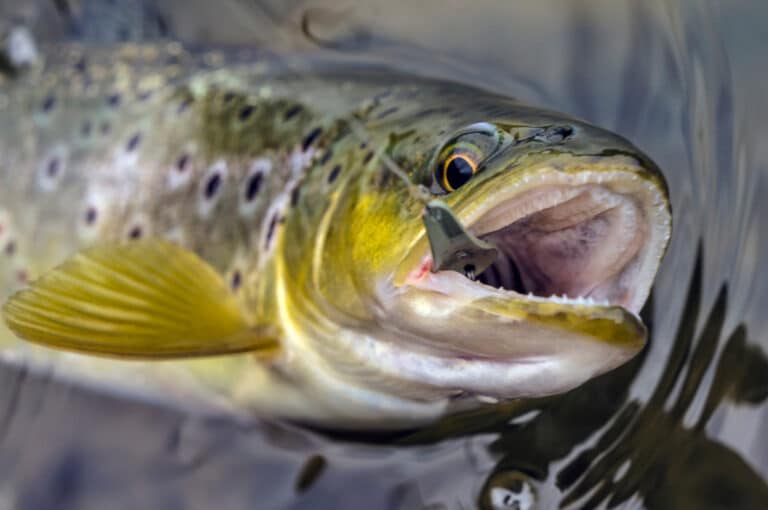If you’ve never fished before in your life, chances are good that your first fish will be a trout. They’re abundant across the United States and are found in every type of water body you can think of. Lakes, city ponds, tiny streams, and even coastal waters all hold this incredible fish.
This makes them highly accessible, and just about anyone with minimal tackle can go out and fish for trout. They’re also fun to fight and catch, and can be caught with a huge variety of presentations. And if you’re just getting into fishing for food (which you definitely should), trout are some of the best fish around for the dinner table (read my post on what rainbow trout taste like for more on that). All of these things make trout an awesome species for learning how to fish.
In this guide, I’ll go over the basics of trout fishing for beginners (with spinning gear; fly fishing is a whole separate article). I’ll cover the fishing tackle required to catch trout, different fishing techniques (including lures and live bait), and how and where to find them. If you’re just looking for something specific, use the table of contents below to get the info you’re looking for.
The Wild Provides is a participant in the Amazon Affiliate program. If you click through one of the links on this site and make a purchase, we may receive a small commission at no extra cost to you. It helps to keep us up and running, but all recommendations are my own honest opinions.
Trout 101: An Overview
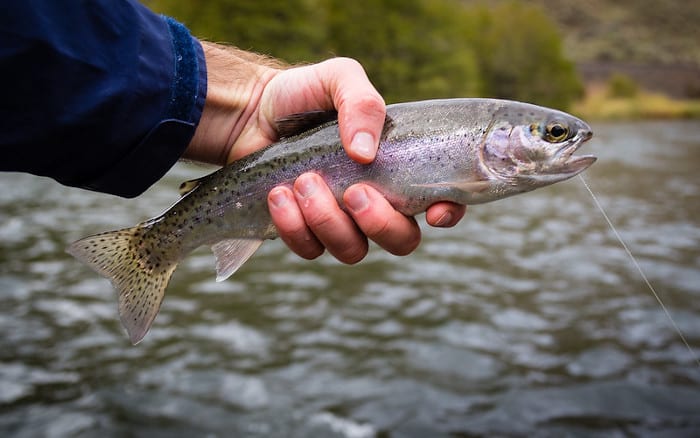
Trout are some of the most commonly fished for game fish in North America. There are several species of trout, each with its own habitat and characteristics, and fishing techniques depend somewhat on what you’re after. Here are the most common species:
- Rainbow Trout: Rainbow trout are the most common and widespread trout in North America, and are some of the most commonly stocked trout. Rainbow trout are found everywhere from small streams to lakes, and even the ocean (though we call them “steelhead” there). The world record catch weighed 48 pounds (!!!), but they are more commonly caught in the 1-5 pound range.
- Cutthroat Trout: Cutthroat trout are an icon of the American West. Characterized by an orange or red slash under the jaw, they are highly aesthetic fish and are very popular among fly anglers. They mostly inhabit cold water, preferring clear streams, rivers, and mountain lakes, and throughout most of their habitat are relatively small (less than 2 pounds). Lake-dwelling varieties can be much larger, though, and the world record cutthroat was 41 pounds.
- Brown Trout: Brown trout are not native to North America, but were introduced from Europe in 1884. They have developed a cult following, though, largely because of their unusual wariness and ability to grow to massive size in relatively small bodies of water. Though they can reach up to 40 pounds, mature fish in the 2-pound range are common.
- Brook Trout: The brook trout is a very common fish, and despite its appearance, is not a true trout. It is a member of the char family, but it inhabits similar waters to the cutthroat. Brook trout (or brookies) are cold water trout, preferring clear, well-oxygenated environments, and are some of the most common fish in alpine lakes and streams. They are generally small, rarely exceeding 5 pounds, and with most catches being less than 1 pound.
- Lake Trout: Lake Trout are also members of the char family. Like brook trout, they prefer cold, well-oxygenated environments. But unlike brook trout, they mainly inhabit large, deep lakes, and can grow to be bigger than any of the trout on this list. The record is almost 102 pounds, though catches even up to about 30 pounds aren’t uncommon.
- “Sea Trout”: “Sea trout” are not actually separate from other trout, but are simply members of any trout species that also live in the ocean (though the term “sea trout” most often refers to ocean-run brown trout). Rainbow trout (called “steelhead” when they also inhabit the ocean) brook trout, and cutthroat trout, can all be “sea trout” when they live in the ocean and coastal rivers and streams.
These are the most commonly fished for trout. There are some others, but the vast majority of recreation angling is for these species.
Trout Feeding Habits: What Do Trout Eat?
If you’re going to catch trout, you need to know what they eat. This depends heavily on where they live, but they can eat everything from small floating insects to birds and mice. Here are some of the things that trout commonly use as food(in rough order from most common to least):
- Aquatic insects (both larvae and adults)
- Worms and leeches
- Crawfish
- Molluscs (freshwater mussels, snails, and slugs)
- Smaller fish
- Frogs and tadpoles
- Birds
- Mice
Yep, trout eat birds and mice. They aren’t all that picky, but because they rely heavily on insects as a food source, it’s very common to fish for them by imitating their local insect population. It’s also common to use lures that imitate other fish, or even soft plastics that imitate any number of the things on this list. I’ll share a few of the best baits and lures for trout below.
Trout Fishing Gear
Before you get started, you’ll need some tackle. Luckily, basic trout fishing tackle required is cheap and accessible. Essentially all you need is a rod and reel, some fishing line, some hooks, and usually some weights. Each can be as fancy or as simple as you want, and a lot of people already have the necessary equipment lying around.
Fishing Rod
For trout, a huge variety of rods work well. But the best options should be:
- Spinning rod between 6 feet and 7 1/2 feet in length
- Light or Ultralight action
- Fast action tip (to detect light bites)
Rods outside of this range will work okay, but these are the characteristics you should look for. These types of rods are extremely common, and many rods with these qualities can be found for under $30. The Ugly Stik Elite (usually around $50; check the price on Amazon here) is a great option.
Check out my guide on light vs ultralight rods for trout fishing to decide between the two options.
Spinning Reel
Any spinning reel in either 1000 series or 2000 series sizes (larger numbers correspond to bigger sizes, i.e. more line capacity) will work great.
1000-size reels are generally better for 2-4 pound test monofilament line. Spooled up with this line, it’ll have plenty of capacity (about 100-150 yards, depending on line diameter) and still cast efficiently.
2000-size reels are best for 4-6 pound test monofilament lines. These reels will hold 120-160 yards of line, and are also more versatile for larger fish where heavier line is required.
Whichever one you go with will catch trout as well as other freshwater fish like bass and panfish. It just depends on if you want versatility or the lightest reel you can get away with. My favorite bang-for-buck reel by fair is the Okuma Ceymar, which runs about $40 bucks on Amazon (and they have both 1000 series and 2000 series sizes available).
Fishing Line
Anglers vary a lot in their line preference, and I wrote a whole article about how to choose the best fishing line for trout. But if you’re just getting started, it’s really pretty simple.
For beginners, go with 4-6 pound test monofilament line. It stretches, so it’s forgiving enough for beginners. It’s also cheap, and it’s available just about anywhere. The last benefit is that it floats, which makes it great for the best beginner trout fishing rigs (which I’ll get into below).
Hooks
Hooks are another area where there are a lot of choices. Hook size can depend on where you’re fishing and what you’re fishing for, so it can be confusing to start. But the general rule is for smaller fish, use a smaller hook.
For small brookies in rivers and streams, anywhere from size 8-12 hooks can work great. For larger rainbows or cutthroat trout, size 4-8 will work better.
As for the type of hook, it depends somewhat on the rig you use. But generally, J-shaped baitholders or circle hooks both work well. Keep in mind that in some places barbless hooks are required, so check your local fishing regulations before you fish.
Weights
You won’t need weights for every trout fishing setup, but it’s good to have some on hand for when you do. Weight is easy; just pick up a split shot variety pack (like this one) and you’ll have everything you need.
Split shot is great because you can just pinch it directly to your line in whatever size you need. You can even double them up if necessary, and this is really all you need for trout fishing weight.
Bait/Lures
Trout fishing can be done successfully on a huge variety of live bait, processed bait (like Powerbait), and lures. It takes a whole article (or two) to go over all the options, but for beginners, the best option is bait. Trout bait is easy to use and it reliably catches fish. Some of the most common baits are:
- Worms
- Berkley Powerbait
- Maggots
- Berkley Honey worms
Any of these baits are great for catching trout. They either have a strong scent, a natural wiggling action, or both, and these are irresistible to the fish. I personally like Powerbait for its ease of use when fishing stocked trout, but if I’m fishing moving water or wild fish then I like to use chunks of worm (or fake worms that imitate natural ones) for their realism and better ability to stay on the hook. I go into a lot more detail in my best trout baits post, so check that out for my favorite baits and extra tips on how to fish them.
Worm fishing can be simple, but there are plenty of ways to increase your success, so check my post on trout fishing with worms for some killer worm fishing tips.
If you’d prefer to use artificial trout lures, I have three that I use all the time. They are:
- Mepps Aglia Spinners
- Rooster Tail Spinners
- Rapala Countdown Lure
- Kastmaster Spoon
These all require either casting or trolling. When retrieved, they have flashy actions and different colors that trout either perceive as injured bait fish, or as something annoying that they want to attack. They’re not quite as reliable for beginners as bait (though they can certainly be better in some situations), but they can be a hell of a lot of fun. I also wrote a whole post on the best trout lures for small streams (that includes these three and 6 others), so check it out here for some more great options. Spoons are also my favorite way to fish for trout, and I wrote a whole post on the best spoons for trout fishing.
Bobber Or Float
Bobbers aren’t required for trout fishing, but often the easiest way to catch trout is to use them.
For beginners, your standard red and white bobber or float that clips onto your line is great. You can often get away with a pretty small bobber, but it’s important to make sure it’ll be buoyant enough to hold your weight.
Fishing License
This isn’t a piece of tackle per se, but a fishing license is always necessary when fishing. Aside from being required by law, it provides money directly to your local state fish and game agency for conservation. License purchases add up directly to better fishing in your state, whether that be through access, habitat restoration, or stocking programs, and I’m all for that.
Fishing For Trout: How To Be Successful
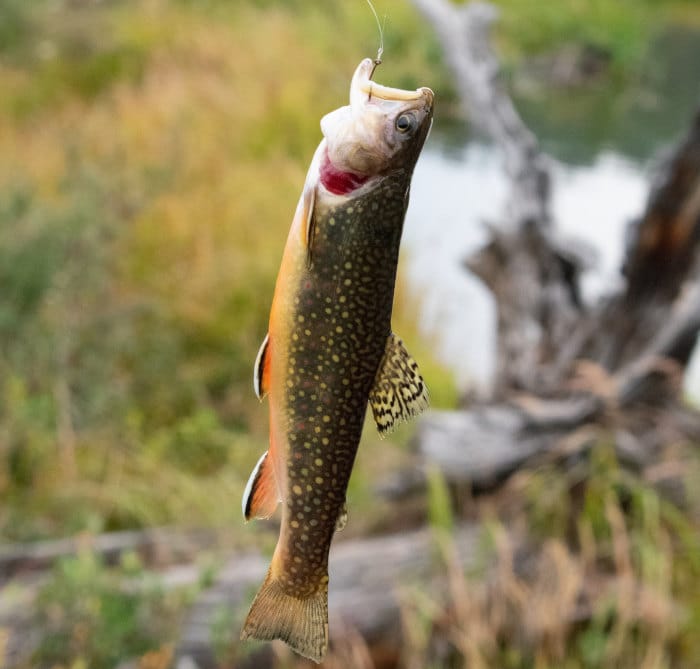
While it’s fairly easy and accessible, trout fishing can still be intimidating to a beginner. There’s no substitute for experience, but I’ll describe the basic techniques of how to fish for trout and where to find them.
Where To Find Trout
Across the United States, trout fishing opportunities are nearly endless. The best way to find an opportunity is to contact your local fish and game office or check their website. Many states (including Oregon and Idaho, where I fish the most) have articles online that outline the best fishing lakes and rivers for specific species in different areas within the state. They also have stocking records, so you can easily see what lakes near you have stocked trout.
You can also go to your local tackle shop and ask where you can find places to fish for trout near your city. Usually, the employees will be happy to point you in the right direction. Public fishing docks and lakes with public shores are fairly common, and these are great places to start.
How To Fish For Trout With Bait
Fishing for trout can be as simple or complicated as you like. But for beginners, the most reliable way to catch them is simple. Just use a bobber and some bait and you’re good to go.
To tie up the basic bobber rig:
- Tie a #6 or #8 hook to the end of your line (or leader, if using) using an improved clinch knot.
- Clip your bobber to the line (through the top and bottom clips) roughly 12 inches from the hook.
- Pinch on a small split shot 2-4 inches above the hook
- Add a worm or some powerbait to the hook
Once you have it set up, cast it out. Then let it sit until you see the bobber start to twitch in the water. Wait until the fish takes the bait (you’ll know when the bobber partially or completely dunks underwater) and it pulls your line tight, then set the hook! Once you know the fish is on, keep steady pressure on it and reel it up.
It really is that simple. You can also use this technique for trout fishing in moving water. It requires casting upstream, letting the rig float downstream, and repeating as necessary, but the basic idea is the same.
Once you get comfortable with basic bobber fishing you can upgrade to slip bobbers or bottom fishing rigs that may be more effective in your area. The key is to keep trying different styles, depths, and techniques until you learn what works best for you.
How To Fish For Trout With Artificial Lures
Fishing for trout with artificial lures can also work really well. It requires a little more technique and knowledge of where trout are likely to be, but once you get the hang of it, it can be super fun, and especially effective on wild trout in a river or stream.
When trout fishing with lures (like Mepps spinners or Rapalas), you need to know where the fish are. This can vary based on the time of day and the type of water body you’re fishing, but you can regularly find trout in areas with cover.
Cover can mean a lot of things. In lakes and ponds, it can mean tall grass or weed beds, submerged logs, or even steep dropoffs into deeper water. In rivers and streams, it can be downstream from rocks, steep or undercut banks, or slow-moving eddies and pools. Center your casting around these areas and you’ll have a better chance of catching fish. Be careful not to cast a lure too close to structure, though, because you can snag and break off.
To get the most out of fishing with lures, experiment with different types and colors. Spinners sometimes work better than Rapalas (and vice versa), and changing up your retrieve speed can also help you catch more trout.
Trout Fishing Tips And Tricks
Aside from general tactics, here are some quick tips to help you catch more fish.
#1. Mix It Up
Trout aren’t super picky, but individual populations do have their preferences. And different times of day, different water conditions, and different locations can all change trout feeding behavior. Trout in a river or stream might prefer something totally different than trout in a lake or pond, so keep a variety of tackle on hand and try different options until you hit a winner.
#2. Catch Them At Feeding Time
You can catch trout at any time of day. But to catch more fish in less time, you should be at the lake when the trout are eating.
Generally, the best times to catch fish are early morning and late evening. This is when the bugs that trout eat are most active, and they’ll be more inclined to take your bait at these times.
#3. Be Where The Fish Are
Trout are constantly moving to find food, so you can catch them anywhere, but you’ll have the best chance if you know where they tend to hang around.
This varies a ton by location. But because trout are cold-water fish, they prefer to be where the water is colder. In a lake or pond, this might be where cold water flows into it from streams. And in the heat of the summer, trout will be deeper in the lake than in the winter.
As I said above, cover is also a great place to start. Weeds, logs, and steep banks are all good places to try.
Final Thoughts
Overall, trout fishing is a great option for anyone who is just learning how to fish. Local stocked ponds are easy to find, and the equipment you need to get started is minimal. A cheap rod and reel, a couple of spinners or spoons, and a baited hook are all you need. If I have one final piece of advice, it’s just to get out there and go fishing! The more you do it, the better you’ll get and the more fun you’ll have.

